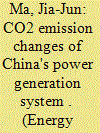| Srl | Item |
| 1 |
ID:
162899


|
|
|
|
|
| Summary/Abstract |
With the rapid development of economy, China's electric power consumption has increased sharply. Its carbon emissions derived from power generation now accounts for more than 45% of the national emissions. This study employs a structural decomposition analysis based on input-output subsystem model to explore sources for emissions increments in China's power sector from 2007 to 2015. Under this approach, the influential factors are classified into four categories. Quite a few scenarios are designed to further assess the impacts of power mix and the levy of carbon tax. The results show that the consumption is the main driving growth factor of CO2 emissions, and most of the emissions are driven by continuing expansion of large-scale infrastructure, and this trend seems going to change in the future; carbon tax and price policies may be the alternative for reducing the emissions. In addition, both the generation efficiency and internal industrial structure are critical factors in emission reduction. Besides, cleaner energy sources effectively lead to carbon emission reduction but this change performs a relatively small effect. Finally, promoting the development of non-fossil energy power may lead to total CO2 emissions perform decrease trend before 2030.
|
|
|
|
|
|
|
|
|
|
|
|
|
|
|
|
| 2 |
ID:
178481


|
|
|
|
|
| Summary/Abstract |
Market-oriented housing reforms and the rapid urbanization process have led to spectacular growth in the Chinese real estate sector (RES). However, the changes in the role played by this sector in the structural dynamics of the Chinese economy have not been examined sufficiently. Accordingly, we analyze the intersectoral structural changes to the Chinese RES, its linkages with the rest of the economy, and its growth sources, using four Chinese input–output tables from 2002 to 2017. We depart from existing work on the RES by using the causative matrix approach and structural decomposition analysis, and obtain three main results. First, the RES, which received little non-RES feedback during the 2002–2007 period, has subsequently received much more substantial feedback. Second, the impact of the RES on China's economic growth stems mainly from its forward linkages. Third, the growth in the RES has been driven mainly by domestic demand expansion. Our results highlight that the Chinese RES, which plays a key role in value chains, is highly dependent on its own final demand and a fall in its demand would impede economic development. An important implication of these results is that developing the national economy by stimulating the RES would not be as effective as developing the RES through stimulating the national economy.
|
|
|
|
|
|
|
|
|
|
|
|
|
|
|
|